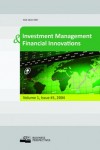Does Fed policy affect blockholder behavior in U.S. publicly traded firms?
Does Fed policy affect blockholder behavior in U.S. publicly traded firms?
Author(s): Halil D. Kaya, Nancy L. Lumpkin-SowersSubject(s): Business Economy / Management, Political economy, Financial Markets, Fiscal Politics / Budgeting
Published by: ТОВ “Консалтингово-видавнича компанія “Ділові перспективи”
Keywords: monetary policy; blockholder; ownership; Federal Reserve;
Summary/Abstract: This paper documents the empirical relationship between ownership concentration and monetary policy to fill out the picture for when ownership concentration is likely to change within U.S. publicly traded firms. The sample is drawn from the Dlugosz et al. (2006) data set for firms between 1996 and 2001. The authors explore the patterns between the Federal Reserve’s policy position and ownership concentration rather than asserting causal direction between the two. This empirical paper tests alternative theories on blockholder activism by examining whether “voice” or “exit” is more dominant under contractionary monetary policy. Using the series of same direction changes in the Federal Funds Rate to establish time periods as a proxy for monetary policy in the U.S., nonparametric tests show that there are more blockholders per firm, the sum of their blockholdings in percentage terms is higher, and the total percentage held by the blockholder in U.S. firms is greater under contractionary policy periods. This supports an active theory of blockholder behavior in corporate governance.
Journal: Investment Management and Financial Innovations
- Issue Year: 14/2017
- Issue No: 1.1
- Page Range: 153-159
- Page Count: 7
- Language: English

